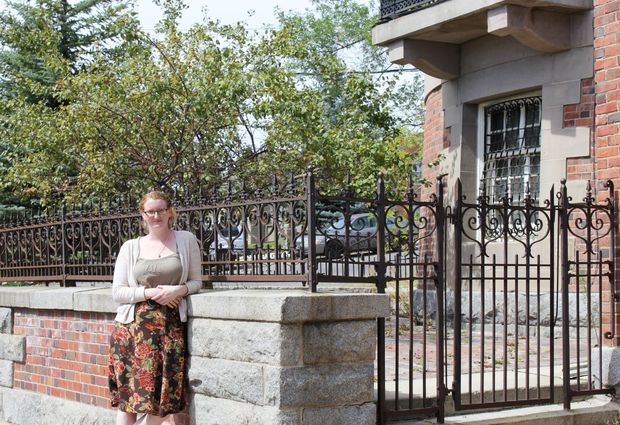Susan Dunlap Montana Standard
There are some things we can’t forget.
Callison Stratton, 24, remembers falling asleep at her living room window as a toddler, her eyes getting droopy as she watched the red light rhythmically flashing from the top of the World Trade Center’s Twin Towers in lower Manhattan, where she grew up.
She also recalls, as a 10-year-old, watching a person jump from the top of the Twin Towers as they burned the morning of September 11, 2001.
“Don’t turn around,” her mother yelled at her as she and her parents fled her middle school building, only blocks from the Towers. She did anyway and saw the jumper. It was only her second day of sixth grade.
She waited anxiously with her family inside their TriBeCa apartment, just north of the fallen Twin Towers, while her 14-year-old brother made the trip home that morning from a different part of the city, amidst the uncertainty and confusion on that cruel day.
She remembers being quarantined, with her family inside their apartment, unable to leave for a few days while lower Manhattan lay in ruins, layers of dust on the windows, smoke pouring from the wounded earth, the foul fumes in the air.
Stratton, the program manager for the historic Clark Chateau, 321 W. Broadway St., Butte, is passionate about memory and how people remember traumatizing events.
She will give a presentation at the chateau on Saturday to discuss how we remember those moments in history, those things we should not — and sometimes cannot — forget.
STORY TO TELL
But Stratton has more than a child’s first-hand account of 9/11 memories to talk about. She has a story to tell about an Irish Hunger Memorial, built in lower Manhattan, just outside the Twin Towers.
Because some of the same survivors of the Great Famine in Ireland traveled west to help the Mining City become “the Richest Hill on Earth,” Stratton feels this is an important story for Butte.
The memorial, intended to remember the victims of the Irish potato famine of 1845-1852, broke ground just months before the Twin Towers fell. On September 12, 2001, workers were supposed to pour concrete to start building the memorial, Stratton said. As the chaos ensued in lower Manhattan due to the terrorist attacks unleashed by Osama Bin Laden on September 11, when two planes flew into each of the towers minutes before 9 a.m., that work ceased.
The memorial was finished about six months later, but what it came to mean changed as a result of that dark and frightening day that took the lives of close to 3,000 Americans, at least for Stratton. A memorial to a painful period from the past, on a distant continent, now stands next to a living reminder of a painful event on our own soil.
Stratton remembers picnicking at the Irish Hunger Memorial as a teenager, herself now a survivor of 9/11, sitting on the memorial’s grassy knoll that is about the size of a football field, surrounded by towers of glass and steel.
HUNGER COTTAGE
An Irish “hunger cottage,” donated by an Irish family and brought brick-by-brick to lower Manhattan, to memorialize the 1.6 million Irish who abandoned their homes to immigrate or who died due to the famine, sits roofless nested in the knoll. Stratton calls it a quiet, contemplative destination in the midst of the mad rush of New York’s financial district.
“The context of this symbol of hunger in such immense wealth is really powerful,” Stratton said.
Because of its location, she said she came to feel the memorial had taken on a dual meaning. For Stratton, it was no longer just a remembrance of the loss the Irish experienced 150 years ago, but it also came to also be about our loss on 9/11. From the site, a visitor can see the Statue of Liberty in the distance. Before One World Trade Center was complete in 2014, a visitor could turn around and also see the devastation wrought from 9/11, where the Twin Towers once stood, Stratton said.
Stratton said she believes Butte should have a memorial to remember the Irish who came here as the result of the famine.
“I hope a conversation is sparked by my presentation,” Stratton said.
She believes building memorials to remember those moments of the past that have inexorably shaped who we have become are necessary.
FIRST-HAND EXPERIENCE
Stratton has first-hand experience with actually building a memorial. When she and her fellow classmates were allowed to return to their middle school, P.S./I.S. 89, six months after the Twin Towers fell, they placed tiles on a wall to permanently commemorate 9/11.
“We need those memorials,” Stratton said over lunch at the Hummingbird Cafe, where she worked when she first came to Butte. The Hummingbird Cafe is also where she wrote most of her thesis, she said.
She received her Master of Philosophy in public history and cultural heritage from Trinity College in Dublin. Stratton said before she left for graduate school, she paid a visit to Butte and fell in love with it. So when she finished her graduate work, she came back. Now Stratton wants to get history out of the so-called “Ivory Tower” and into the hands of you and me.
“These moments never leave us,” she said.


